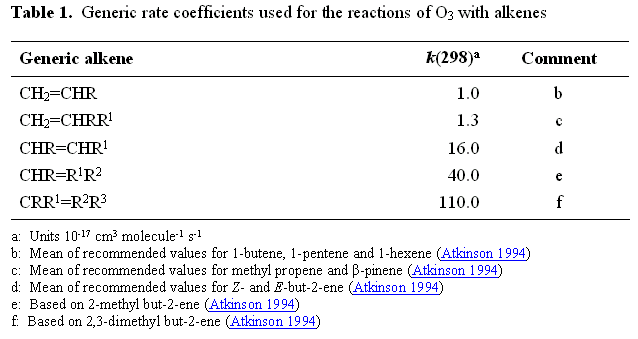Reaction Documentation for
O3 initiation reactions
O3 initiated degradation chemistry is included for those VOC for which both the following relations apply:
These relations were formulated on the basis that typical ambient concentrations of OH and O3 in the boundary layer are 106 and 1012 molecule cm-3, respectively. Thus, the first criterion applies when the removal rate by reaction with O3 exceeds 1 % of the removal rate by reaction with OH, and the second when the lifetime of the VOC with respect to reaction with O3 is less than 107 s (ca. 100 days). O3 initiated degradation is expected to be important only for alkenes, dienes, monoterpenes and some unsaturated oxygenated products.
Rates of initial reactions
Rate coefficients for the reactions of O3 with alkenes, dienes and monoterpenes have been reviewed by Atkinson (1994; 1997a), Atkinson et al. (1999) and Calvert et al., 2000 with recommendations made in many cases. These recommendations are used unless superseded by more recent evaluations. If recent laboratory determinations are available, which are likely to influence, or form the basis of future recommendations, these are also taken into account. Where no experimental data exist for monoalkenes, an appropriate generic rate coefficient defined by analogy is used, as indicated in Table 1.

Initial products
The reaction mechanisms follow the general pattern described by Atkinson (1997a) and Calvert et al. (2000), with addition of ozone to the double bond leading initially to the formation of an energy rich primary ozonide. This ozonide decomposes rapidly by the two possible channels, each forming a carbonyl compound and a Criegee biradical, which also possesses excess energy (denoted ‡):
| O3 + RR1C=CR2R3 | → | RC(O)R1 + [R2C(OO)R3]‡ | (1a) |
| → | R2C(O)R3 + [RC(OO)R1]‡ | (1b) |
Available data on primary carbonyl product yields indicate that both channels typically make an important contribution to the reaction (e.g. Calvert et al., 2000), although formation of the more alkyl substituted Criegee biradical tends to be favoured. As described previously (Jenkin et al., 1997), the two channels are currently assumed to compete equally in the majority of cases in the MCM. For α- and β-pinene, however, the route forming the more substituted Criegee biradical is assigned a higher probability of 60%. Note that in the case of α-pinene (and other endocyclic alkenes) the product of either reaction (1a) or (1b) is a Criegee biradical of the same carbon number as the parent VOC, which also contains a carbonyl substitution (i.e. separate carbonyl and biradical products are not formed).
In the case of the unsymmetric diene, isoprene (the only such compound currently considered in the MCM), addition of ozone to the less substituted double bond is assumed to be favoured relative to the more substituted double bond by a factor of 1.5, which is in accordance with the results of Grosjean et al. (1993) and Aschmann and Atkinson (1994)
 ME2BUT1ENE
ME2BUT1ENE
 CH2OOC
CH2OOC
 MEK
MEK